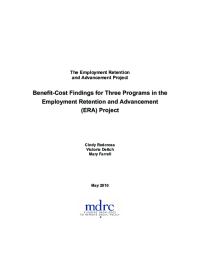Benefit-Cost Findings for Three Programs in the Employment Retention and Advancement (ERA) Project
This report presents an analysis of the financial benefits and costs of three diverse programs designed to increase employment stability and career advancement among current and former welfare recipients. The programs are part of the national Employment Retention and Advancement (ERA) project, which tested 16 models in eight states. Each program was evaluated using a random assignment research design, whereby individuals were assigned, at random, to the ERA program group or to a control group that received services generally available in the sites’ communities. MDRC is conducting the ERA project under contract to the Administration for Children and Families (ACF) in the U.S. Department of Health and Human Services.
The analysis focuses on three programs that operated in four sites:
- Corpus Christi and Fort Worth, Texas. This ERA program targeted welfare applicants and recipients who were seeking work; it used financial incentives and other services to help participants find jobs, stay employed, and increase their earnings.
- Chicago, Illinois. This ERA program targeted welfare recipients who were working steadily but earning too little to leave the welfare rolls; partly by helping individuals to change jobs, it aimed to increase participants’ earnings.
- Riverside County, California. The Riverside Post-Assistance Self-Sufficiency (PASS) ERA program targeted individuals who had left welfare and were working; services were delivered primarily by community-based organizations to promote retention and advancement and, if needed, reemployment.
These programs were selected for this report because, as described in other ERA documents, comparisons between the program and control groups indicated that these programs increased individuals’ employment and earnings — the primary goal of the project. The benefit-cost analysis presented here provides an overall accounting of the financial gains and losses produced by the programs from three perspectives: those of the ERA program group members, the government budget, and society as a whole. The analysis also examines whether the government’s investment in these programs was cost-effective. The study’s key findings follow:
- Program group members were better off financially as a result of the ERA programs. All three programs produced net financial gains from the perspective of program group members.
- From the perspective of the government budget, Riverside PASS essentially broke even, but the ERA programs in Chicago and Texas did not produce net savings. That is, the additional amount spent on ERA services was not recouped by welfare savings and increased tax revenue.
- All three ERA programs produced financial gains for society as a whole. Combining both net gains and net losses from the perspectives of the program group and the government budget, the programs led to financial increases for society. Riverside PASS had the largest gains because it increased program group members’ income at no net cost to the government.
- For every dollar that the government invested in these ERA programs, program group members gained more than one dollar. This suggests that the three ERA programs were cost-effective.
As part of the ERA project, over a dozen different programs have been evaluated, and most did not produce consistent increases in employment retention or advancement, suggesting that it is difficult for these types of programs to attain positive effects. The three programs highlighted here did have positive effects, and while these effects were generally achieved at a cost to the government, all three programs produced net financial gains for program group members, and they did so by amounts that were more than the government spent to provide the services.






